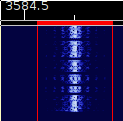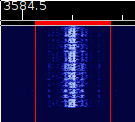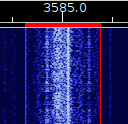
CW 20 WPM
Spectrum
Sound

CW 40 WPM
Spectrum
Sound

CW 100 WPM
Spectrum
Sound

CW 20 WPM Spectrum Sound |

CW 40 WPM Spectrum Sound |

CW 100 WPM Spectrum Sound |
CW (Continuous Wave) is something of a misnomer, since the carrier of a CW transmission is anything but continuous! The name comes from the early days of radio where the alternative was Spark, where the transmission was of a damped wavetrain generated by non-electronic means.
CW is generally transmitted using on-off or 100% amplitude keying, i.e. ASK modulation. Coding is invariably Morse (Albert Vaile) varicode, using a wide range of abbreviations. Transmission can be manual or by electronic keyer or computer, and reception can be aural or by computer. Computer reception works best at high speed under noise-free conditions with computer sent transmissions. Reception is limited at lower speeds as noise between characters or during fades is frequently misinterpreted (use RF gain to reduce noise and limit AGC action).
A linear transmitter is not required, although the keyed elements must be well shaped to avoid clicks which considerably increase the bandwidth. A risetime of 4ms is normal, although 1ms is best at higher speeds.
CW is a manually controlled message asynchronous simplex chat mode, used without Forward Error Correction. The default calling mode is typically about 15 WPM.
The Morse varicode with a limited character set. More common characters are sent faster. Character synchronization is defined by element spacing - three element spaces between characters, seven between words. Modulation is on-off.
| Mode | Symbol Rate | Typing Speed1 | Duty Cycle2 | Bandwidth3 | ITU Designation4 |
| CW205 | 10 baud | ~ 2 cps (20 wpm) | ~ 44% | 50 Hz | 50H0A1A |
| CW40 | 20 baud | ~ 4 cps (40 wpm) | ~ 44% | 100 Hz | 100HA1A |
| CW100 | 50 baud | ~ 10 cps (100 wpm) | ~ 44% | 200 Hz | 200HA1B6 |
1. WPM is based on typical word 'PARIS', plus word space (50
dot-length elements). Values are approximate because a variable
length code is used.
2. Transmitter average power output relative to a constant carrier
of the same PEP value. Duty cycle is calculated using the same
standard word, but clearly duty cycle also depends on keying
'weight'. The word 'PARIS' contains 22 key-down elements.
3. This is the "Necessary Bandwidth" as defined by the ITU.
4. A summary of the ITU Designation system can be found at